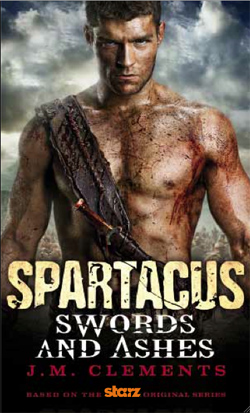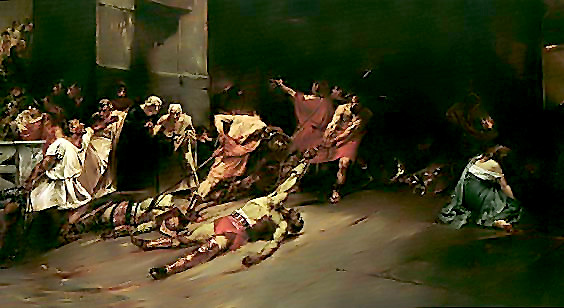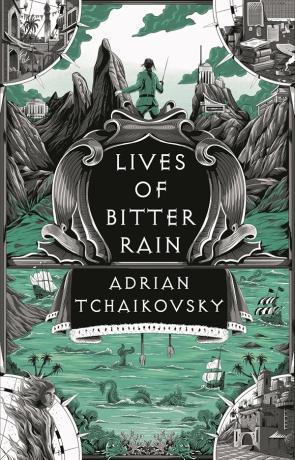I AM SPARTACUS!

Well ok not really, but I do have the next best thing and that's a guest blog by the real actual author of Spartacus: Swords & Ashes - J.M. Clements.
SPOLIARIUM
Author J.M. Clements on his novel Spartacus: Swords & Ashes
Starz were playing their cards very close to their chests about events in the Spartacus: Vengeance TV series. You don’t need a spoiler warning to know the broad historical details. You can get those right now in Plutarch and Appian, Florus and Frontinus. But as for the character details, they weren’t telling until long after my book would need to be delivered. It was too risky to set the first Spartacus novel anywhere near the second season. Instead, it would have to slot somewhere in the first season.
But thanks to those advanced spoilers from the likes of Plutarch, I also knew that while there would still be a couple of upcoming gladiatorial events onscreen, Spartacus’ days in the arena were over. This book could be the last chance to get back to the blood and sand, and show a gladiator’s life in intricate detail.
So I decided that I would make sure that Spartacus: Swords & Ashes included a bird’s-eye view of a whole day at the games, showing all those elements that never quite make it onto television. The crappy, low-rent animal-baitings before lunch-time. The midday executions. The clowns and the clean-up men. The doomed slaves who refuse to cooperate and the crowds that behave contrary to expectations. Behind the scenes, the trumpeters who have to knock up fanfares on command, and the stage manager trying to keep it entertaining, the food sellers and the groupies. And the end of it all, the man with a knife who cuts up the dead for dog-meat.
There’s a famous 1884 painting by the Filipino artist Juan Luna, The Spoliarium, which presents a deliberately shabby, unglamorous perspective on gladiatorial games. There’s no roaring crowd here, no flash of arms or glittering prizes. Instead, dead carcasses are dragged out of sight, while a woman weeps over a lost love, and crook-backed, covetous old men stare indifferently at the slaves who died to entertain them. The picture stands today in pride of place at the entrance to the National Museum of the Philippines, dominating an entire wall, confronting every visitor with the sight of the dark underside of Empire.

This is what Spartacus is really about: the true costs of the garish free entertainment of bread and circuses, themselves doled out to Roman citizens to buy their votes and support for foreign wars and domestic corruption. Spartacus remains famous today because he stood up to the terrible state of a world in which one in three human beings is a slave with no rights. It’s why the story has become such a touchstone of rebellion, and why it still has such resonances two thousand years after it was first told.
Spartacus: Swords & Ashes is available now in the US in paperback and on Kindle and released in the UK on the 27th January.
News Archives
- August 2024
- July 2023
- April 2023
- February 2023
- September 2022
- March 2022
- February 2022
- July 2021
- June 2021
- April 2021
- March 2021
- January 2021
- October 2020
- September 2020
- June 2020
- March 2020
- May 2019
- January 2019
- November 2018
- January 2016
- September 2015
- August 2015
- July 2015
- June 2015
- May 2015
- April 2015
- March 2015
- January 2015
- October 2014
- June 2014
- April 2014
- March 2014
- February 2014
- January 2014
- December 2013
- November 2013
- October 2013
- September 2013
- June 2013
- May 2013
- April 2013
- March 2013
- January 2013
- December 2012
- November 2012
- August 2012
- July 2012
- June 2012
- May 2012
- April 2012
- March 2012
- February 2012
- January 2012
- December 2011
- November 2011
- October 2011
- September 2011
- August 2011
- July 2011
- June 2011
- May 2011
- April 2011
- March 2011
- February 2011
- January 2011
- December 2010
- November 2010
- October 2010
- September 2010
- August 2010
- July 2010
- June 2010
- May 2010
- April 2010
- March 2010
- February 2010
- January 2010
- December 2009
- November 2009
- October 2009
- September 2009
- August 2009
- July 2009
- June 2009
- May 2009
- April 2009
- March 2009
- February 2009
- January 2009
- December 2008
- November 2008
- October 2008
- September 2008
